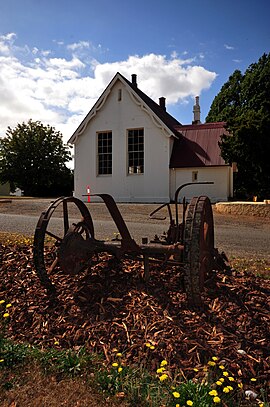| Hagley Tasmania | |||||||||||||||
|---|---|---|---|---|---|---|---|---|---|---|---|---|---|---|---|
 Hagley Farm School's original 1865 building | |||||||||||||||
| Coordinates | 41°31′34″S 146°53′04″E / 41.52611°S 146.88444°E | ||||||||||||||
| Population | 335 (2016 census)[1] | ||||||||||||||
| Established | 1866 | ||||||||||||||
| Postcode(s) | 7292 | ||||||||||||||
| Elevation | 150 m (492 ft)[2] | ||||||||||||||
| Location |
| ||||||||||||||
| LGA(s) | Meander Valley Council | ||||||||||||||
| Region | Launceston | ||||||||||||||
| State electorate(s) | Lyons | ||||||||||||||
| Federal division(s) | Lyons | ||||||||||||||
| |||||||||||||||
| |||||||||||||||
Hagley is a rural locality and town in the local government area of Meander Valley in the Launceston region of Tasmania. The locality is about 5 kilometres (3.1 mi) north-east of the town of Westbury. The 2016 census has a population of 335 for the state suburb of Hagley.[1]
The area was used by the Port Dalrymple—an early name for George Town in Northern Tasmania—Aboriginal Tasmanians until they were driven from their lands by European settlement. Land grants from the 1820s, to William Thomas Lyttleton, William Bryan and Sir Richard Dry, led to the first buildings, and later gazetting of the town in April 1866. Lyttleton was associated with Hagley Hall in England; his naming of his estate led to the town's name, and he is believed to have bequeathed the town's land. Hagley is an agricultural centre sited on largely alluvial soil near the Meander River. As of 2011[update], the town had a population of 330, most of whom were Australian born. Hagley is remembered as the first site of coursing in Tasmania, which started at Quamby Estate in 1878. The town has had cricket and Australian rules football teams, but it no longer fields teams.
There are four church buildings in Hagley. A Presbyterian church opened in 1879; it is now closed and in private hands. The Uniting Church building is a Modernist design built in 1957; it sits next to a wooden Methodist chapel built in 1859. St Mary's Anglican Church is a bluestone Gothic Revival building that opened for services in 1862. The lands and a significant part of the church's funds were donated by Sir Richard Dry. Dry is buried at the church and the church's tower is dedicated to his wife. Hagley Farm Primary School is the oldest agricultural school in Australia. It began as the Hagley State School in 1865 and became an area school for the surrounding districts in 1936. The school has a 64-hectare (160-acre) farm and agriculture features strongly in its curriculum.
The town has some 19th-century buildings listed on both the Register of the National Estate and the Tasmanian Heritage Register. Hagley Mill is noted as possibly the only extant mill in Australia that was horse-driven. Quamby Estate, the former estate of Sir Richard Dry, is run as a tourist attraction and has a 9-hole golf course. Hagley's reticulated water supply is sourced from a filtration and treatment plant at nearby Westbury. This plant opened in 2013; from 1902 until then the town had received untreated water. From 1871 the town was serviced by passenger rail, but this ceased prior to 1978. Hagley was originally on the main road from Launceston to Deloraine, but was bypassed in 2001 when the Hagley section of the Bass Highway was completed.
- ^ a b "2016 Census Quick Stats Hagley (Tas.)". quickstats.censusdata.abs.gov.au. Australian Bureau of Statistics. 23 October 2017. Retrieved 13 September 2020.
- ^ Cite error: The named reference
soil1was invoked but never defined (see the help page). - ^ a b c Cite error: The named reference
rainwas invoked but never defined (see the help page).
